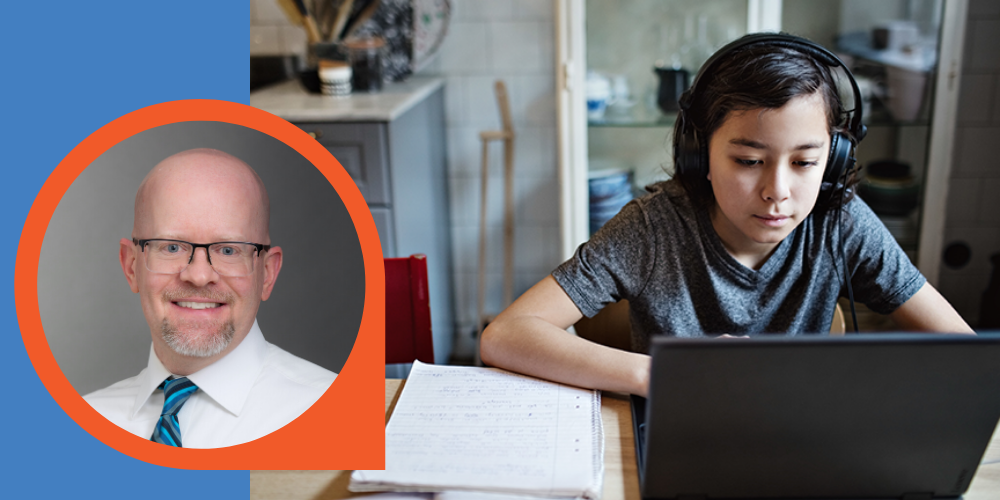By Jamie Martin, Assistive Technology Specialist
Let’s face it. Most of us were caught flat-footed when schools were forced to close their physical doors as part of a collective effort to slow the spread of the novel coronavirus. Until then, the 2019-2020 school year was progressing like most others. In many classrooms, traditional learning activities involving pencil and paper (and perhaps a Google doc or two) were followed by assessments like quizzes, tests, and slide show presentations.
Then, with little to no warning, education completely changed. Physical classrooms were replaced with virtual meetings, during which family pets joined teachers and students. Rigid bell schedules were gone, substituted by flexible school days combining synchronous and independent work. Traditional grading was changed to pass/fail. And students with disabilities abruptly lost the in-person support systems provided by special education teachers, paraprofessionals, and those who provide related services. Some students, particularly those with learning disabilities like dyslexia, have been able to connect with their teachers to receive online support. Others have had to rely on help from family members who may not be prepared to give it. What has been missing for many students with learning disabilities, at the worst possible time, is assistive technology (AT).
People often look for silver linings in difficult situations. As an assistive technology specialist, my hope is that one positive outcome of distance learning is that educators and parents will take a fresh look at equipping students with learning disabilities with AT tools that provide academic independence. At a time when children may not be benefiting from in-school support, they can be using assistive technology to get the help they need. Even though it may seem like too much to add to the new normal of digital learning, teachers and parents need to shed their reluctance in order for kids to receive the appropriate education they deserve. It doesn’t need to happen all at once. There are a few basic assistive technology tools that can go a long way. Here is what I suggest as a starter kit for students with learning disabilities.
Start With These Built-in Accessibility Features
Most device operating systems have built-in assistive technology tools. For students with learning disabilities, those tools include text-to-speech, dictation, and word prediction. For more information on what you can find built into the device that your student or child is using, follow these links:
- Chrome OS (Chromebooks)
- iOS / iPadOS (Apple mobile devices)
- Windows 10 (Windows computers)
- macOS (Apple computers)
Bookshare Makes Reading Easier
Bookshare is a free, online library for students with dyslexia, blindness, cerebral palsy, and other reading barriers. Students can customize their reading experience with ebooks in audio, audio + highlighted text, braille, large font, and other formats. The Bookshare library contains over 850,000 titles that can be read with a variety of assistive technology tools, including these mobile apps:
- Dolphin EasyReader (Apple iOS and Android devices – free)
- Voice Dream Reader (Apple iOS and Android devices – paid)
- Go Read (Android devices – free)
- Capti Voice (Apple devices – free and paid versions)
For more information, watch this webinar: 6 Ways to Access Bookshare Books.
Optical Character Recognition Apps
Optical Character Recognition (OCR) tools allow students to take pictures of paper handouts and worksheets and have the text read aloud with text-to-speech technology. Because of their ease of use, I suggest using the following OCR apps on smartphones or tablets:
- Prizmo Go (Apple devices)
- ClaroPDF Pro (Apple and Android devices)
- Office Lens (Apple and Android devices)
- Voice Dream Scanner (Apple and Android devices)
Assistive Technology Can Make the Future of Education Less Uncertain
We do not know exactly how the 2020-2021 school year will look, so it’s important that we prepare all students, especially those with disabilities, to be ready to complete more work independently than was required in the past. Even if school buildings host in-person classes in the fall, I expect that there will be times when schools will need or decide to utilize distance learning again. We may even see remote learning days built into the calendar. Inclement weather cancellations will likely be a thing of the past because teachers now have the experience and confidence to meet with their students online when snow keeps them home. Assembling assistive technology toolbelts will be a critical element of a new model of education that, although still evolving, is here to stay.
The COVID-19 distance learning experiment has given us an opportunity by opening the door to more effective AT implementation. Now we just need to step aside and welcome it in.
Jamie Martin is an assistive technology specialist at New England Assistive Technology (NEAT) in Hartford, CT. He specializes in assistive technology for dyslexia and other learning disabilities. He works with school districts throughout Connecticut, providing evaluations, consultations, trainings, and professional development. @NEATwithJamie


Be First to Comment